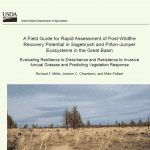A field guide for rapid assessment of post-wildfire recovery potential in sagebrush and pinon-juniper ecosystems

View field guide.
This field guide provides a framework for rapidly evaluating post-fire resilience to disturbance, or recovery potential, and resistance to invasive annual grasses, and for determining the need and suitability of the burned area for seeding. The framework identifies six primary components that largely determine resilience to disturbance, resistance to invasive grasses, and potential successional pathways following wildfire, as well as the information sources and tools needed to evaluate each component.
The components are: (1) characteristics of the ecological site; (2) vegetation composition and structure prior to the wildfire; (3) fire severity; (4) post-wildfire weather; (5) post-wildfire management, especially grazing; and (6) monitoring and adaptive management.
The tools provided are: (1) a conceptual model of the key components that largely determine resilience to disturbance and resistance to invasive annual grasses of the burn area, (2) a guide to evaluate post-wildfire severity, (3) indicators to estimate pre-wildfire plant composition and structure if not known, and (4) an evaluation score sheet to rate an area’s potential post-wildfire resilience to disturbance, resistance to invasive annual grasses and, thus, the need for seeding and probability of success.

